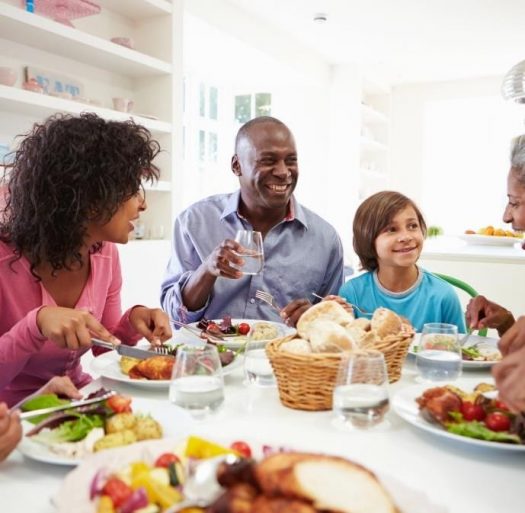By Robin Allen MSPH, RDN, LDN
When my children were growing up have the family together for mealtimes was important not always possible. My husband worked odd hours frequently when he was not there until the kids were in bed. So I confess to succumbing to faster, more convenient foods. Then as they grew up activities started interfering and we found ourselves at a drive-through between work, cross country, cheerleading, school plays, music lessons, gymnastics, ice skating etc. Sometimes nutrition and family meals took a back seat to a busy schedule. I wish I had appreciated the importance of making time for family meals.
The following are some key takeaways and resources shared in the webinar.
At the beginning of the webinar, we asked the participants the following question. Below are the answers given by the participants. I can certainly relate to all of them!
What do you consider the major barriers to sharing meals for contemporary families?
Time, media, busy lifestyles, picky eaters, evening activities, many younger families to not know how to cook, no cooking skills, children’s schedules, sports, clubs, lack of cooking skills, conflicting schedules, unplugging, working mom, adult schedules, children are over-involved and there is no time left for family, fast food is easy, money, working parents, home cooking is too hard, too much time too costly,
The Key Elements for Healthy Mealtimes
- Planning ahead
- Positive Communication
- Reduce Noise and Distraction
- Flexible enough to meet the demands of busy family life
Notes from the webinar to help with family mealtimes:
Create a routine, with time, place predictability, a role for all, order repetition, flexibility, a sense of control, and efficacy.
Frequently mealtimes are filled with chaos, variable times, random settings, unpredictability, shifting roles, lack of order, feeling out of control, stress and strain, a sense of urgency, and background noise.
Mealtime FAQs:
- Most shared family mealtimes last between 18-20 minutes
- 63% of family members eat dinner together “frequently” or “always”
- Families with children under 18 eat dinner together “frequently” or “always” 77% of the time
- 86% of parents agreed that dinnertime was the best time for family members to get together and talk, next best place is in the car.
Primary barriers to sharing meals in families with preschool-aged children:
Problematic Behavior
- Sibling Fights
- Picky Eating
- Child Tantrums
Scheduling Difficulties
- Parent Work
Support from Partner
- 46% of families interviewed in a CDC report stated they had a television where they ate.
- Parents of young children report using television during mealtimes as a way to avoid conflict.
Integrated Advertising
- Advergames
- Social Media
- Adolescents equate quality of information with quantity (e.g., viral videos)
- Young children and adolescents equate nutrition quality with positive emotions evoked during advergames.
Resources for Families or Providers:
Ann Hall MRE, RDN, LDN Child Nutrition Programs, NETTA Division shared the following USDA resources after the webinar:
Our Team Nutrition website has information for families as well as child care centers and schools on feeding children at www.fns.usda.gov/tn/team-nutrition. Team Nutrition provides MyPlate materials that are developed specifically for kids and their parents/caregivers. Evidenced-based curricula that educators can use to integrate MyPlate lessons into core educational subjects, such as Math, English Language Arts, and Science is also available.
Check out FNS’s new mobile app Food Buying Guide. The Food Buying Guide (FBG) is the essential resource for food yield information for all Child Nutrition Programs (CNP). Go to www.fns.usda.gov/tn/food-buying-guide-mobile-app to download the app.
Resources shared in the chat:
Turn mealtime into “family time” with ideas and tips from the Human Performance Resource Center. www.hprc-online.org/articles/turning-mealtime-into-family-time
Check out this blog from Dr. Fiese on family mealtimes and why they matter: https://infoaboutkids.org/blog/family-mealtimes-why-do-they-matter/
For more resources, check out The Family Dinner Project. “The Family Dinner Project is a growing movement of food, fun, and conversation about things that matter. We are a nonprofit organization currently operating from the offices of Project Zero at Harvard University” thefamilydinnerproject.org
Some of the research on family mealtimes being beneficial in nutrition and reducing childhood obesity. https://www.ncbi.nlm.nih.gov/pmc/articles/PMC3387875/
This is a really great resource for those with young children, to help establish a healthy relationship with food and feeding early on to last a lifetime https://healthyeatingresearch.org/wp-content/uploads/2017/02/her_feeding_guidelines_report_021416-1.pdf
Ellen Satter https://www.ellynsatterinstitute.org/ The Ellen Satter Institute helps thousands of parents, grandparents, children, teens, adults and health professionals to provide a healthy relationship with food for health and well-being.
Additional references and resources from the event page https://oneop.org/wp-content/uploads/2018/05/Additional-Resources-The-Power-of-Family-Mealtimes-August-21.pdf
How do you facilitate family mealtimes with your family or with your clients/patients? We would love to get your feedback!















